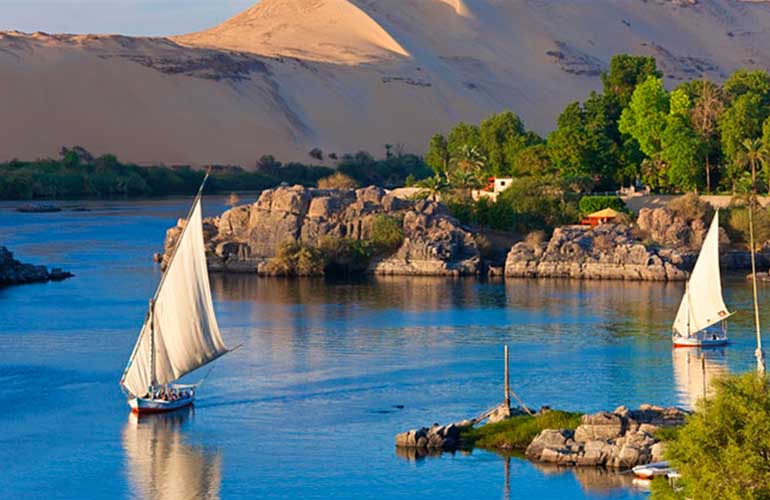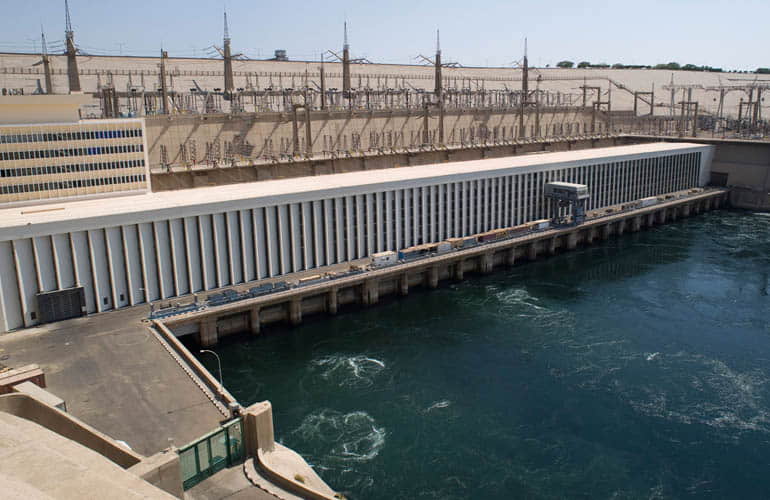City of Aswan in Egypt
Aswan is the main city in southern Egypt and the third-largest in Egypt. It is known for the famous dam and for being the starting point for one of the most famous temples in Egypt: Abu Simbel. Like other cities in Egypt, Aswan has been built on the banks of the river, but here the rock formations and islets that jut out between its waters give the view a special charm. Exotic, picturesque and modern in style, Aswan has traditionally been a city of commerce. In ancient times, all kinds of goods such as gold, ivory and exotic animals from Nubia were brought here. This spirit of trade and passing through is still evident in its atmosphere and makes Aswan one of the most interesting destinations in Egypt.
Aswan is the base for excursions to the temples of Philae and Kalabasha, near the great dams beyond the First Cataract, and to the Sun Temple of Ramses II at Abu Simbel, far south.
The city of Aswan is the southernmost city in Egypt, located on the eastern bank of the Nile River, at about 950 km south of the city of Cairo. It has a population of 275,000 (2008) and is 106m above sea level.
Aswan is the ancient city of Swenett, a name derived from the deity with the same name, however, in classical antiquity, it was called Siena (Syene) from which Aswan is derived.

The city is noted for its granite quarries called syenite, which was used to build monuments and buildings that we can still see today as is the case with the pyramids.
In addition, in the area where the stone cutters worked more than 3000 years ago, one can observe the blows with the picks used for the extraction of the natural stone marked on the surface of the stone.
The best city of Egypt and the old border town has the most beautiful location on the Nile.
At ASWAN the deserts approach the river and border its sparkling blue between amber sand and granite extrusions.
Late blessed feluccas glide past the ancient time and gigantic rocks of the Elephant Island, palm trees and tropical shrubs soften the islands and embankments until the intense blue sky turns into soft darkness.
It is also the best starting point for excursions to Darrow Camel Market and the temples of Kom Ombo and Edfu, between Aswan and Luxor. Although Kom Ombo and Edfu are easier to reach by road, the classic approach is to travel downstream with feluccas and experience the moods and landscapes of the Nile as they have been for millennia – or on a luxury cruise. Aswan itself is relaxed to the point of the Torpor, with a local tourism scene that is essentially similar to that of Luxor, but far less dynamic.

Aswan Dam
The Great Dam of Aswan was built 111 meters above sea level, with the aim of safeguarding the Egyptian territory from the powerful floods of the Nile, which caused frequent flooding. These episodes, which damaged the land used for agriculture and nearby villages, ceased after the dam was built.
Properly channeled and used for irrigation and electricity, the force of the Nile waters now provides energy to all of Egypt. The famous Lake Nasser, named after President Gamal Abdel Nasser who started the work in 1956, was derived from its construction.
From the High Dam of Aswan, you can see across the lake the great natural reserve that was created along with it, the power station in the north and the temple of Kalabsha in the south.
However, it was not all good news after the completion of the works. Problems soon began to arise due to the constant flooding of Lake Nasser, which began to inundate the Nubian monuments located around it. In 1960, efforts to rescue them resulted in their being moved to places where they are safe today.

Aswan city of Egypt is famous for:
It is also the best starting point for excursions to Darrow Camel Market and the temples of Kom Ombo and Edfu, between Aswan and Luxor. Although Kom Ombo and Edfu are easier to reach by road, the classic approach is to travel downstream with feluccas and experience the moods and landscapes of the Nile as they have been for millennia – or on a luxury cruise. Aswan itself is relaxed to the point of the Torpor, with a local tourism scene that is essentially similar to that of Luxor, but far less dynamic.
During the populated times, the huge trade in ivory, slaves, gold, silver, incense, exotic animal skins, and feathers led to a market town on the eastern shore, but the island remained of great importance throughout the classical period, when it was known by its Greek name Seyene.
Aswan weather
Located near the Tropic of Capricorn, Aswan is almost always hot and dry, with average daytime temperatures ranging from delicious 23-30°C in winter to sour 38-54°C in summer. In late January and early February, many Egyptians visit Aswan, block-book seats in trains from Luxor and Cairo. Late autumn and spring are perfect times to visit as they are less crowded than the winter high season but not as invigorating as summer (May-October).
What to visit in Aswan
If you decide to approach the city, there are many tourist interests that make our visit worthwhile:
1. The most beautiful sunrise in Egypt is here:
Watching the sun begin to shine over the Nile is an absolutely spectacular experience in this city. Prepare yourself a good tea, your camera and start enjoying this luxury for your eyes.
2. Visit a Nubian Village:
There are several excursions to explore the colorful streets of the Nubian villages. Don’t hesitate for a second, this is one of the experiences you will have in Aswan.
3. Stay in the heart of a Nubian village:
Much better if instead of just taking a tour of its streets you stay there directly. Walk at your own pace through the streets of the village and give yourself the pleasure of stopping to talk to the people who live there. The Nubians are very hospitable and are eager to talk to travelers.
4. Philae Temple
Philae Temple is well worth a visit. Rescued from the bottom of the water, after being flooded by the Aswan dam, today the temple looks almost intact on the island Agikia in the middle of the Nile. In 1979 it was declared a World Heritage Site by UNESCO. Before getting on the boat.
5. Unfinished obelisk:
It may look like just a piece of stone to you, as it did to me at first. However, when you look at it carefully you begin to wonder how they would have transported it, how would they have managed to get the obelisk over 30 meters long and 1,000 tons straight? That’s the mystery of the Obelisk. You should also know that the Aswan granite is very peculiar because of its reddish color and you will see it in many of the temples in Egypt.
6. Nubian Museum
The Nubian Museum has 3000 pieces that represent different periods of Egypt such as prehistoric, pharaonic, Ptolemaic, Coptic and Islamic.
In the botanical garden, we can find a great variety of exotic plants and trees from all over the world.
7. Elephantine Island
The Elephantine Island, which separates the Nila River in two channels and whose name is given because the rocks and the color of these simulate the elephants, is famous because it has remains of the temples of Jnum, State and his son Anukis, and we can also find the Nilometer, a system that allowed the Egyptians to measure the river’s floods.
8. Monastery of Saint Simeon
The Monastery of Saint Simeon built in the 12th century A.D. is also very interesting to see, where the missionary monks converted Nubians into Christians.
9. Aswan city tour
if you feel like going shopping, in the souk of Aswan you can buy handicrafts, marquetry, spices, and saffron, among many others.





